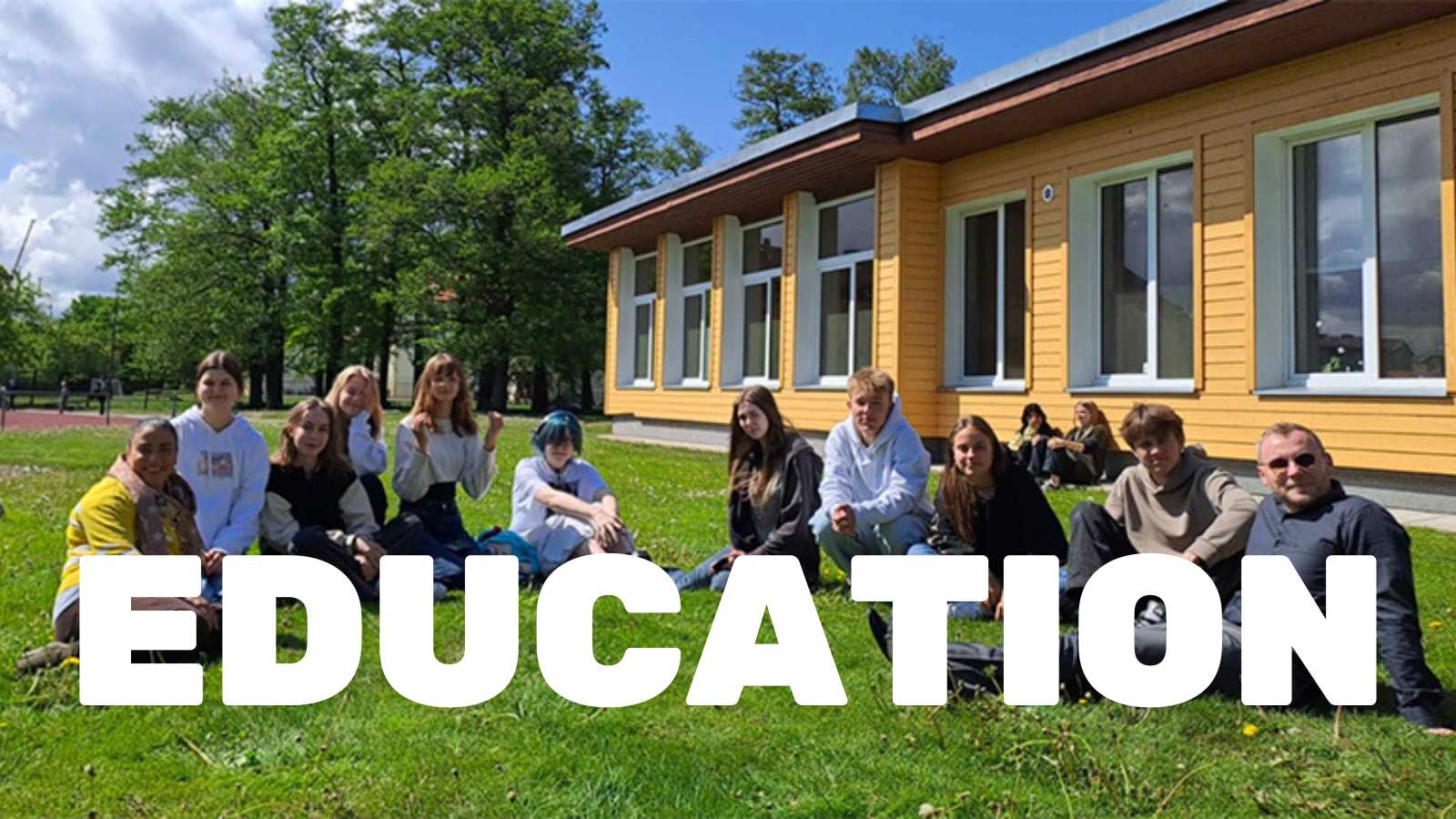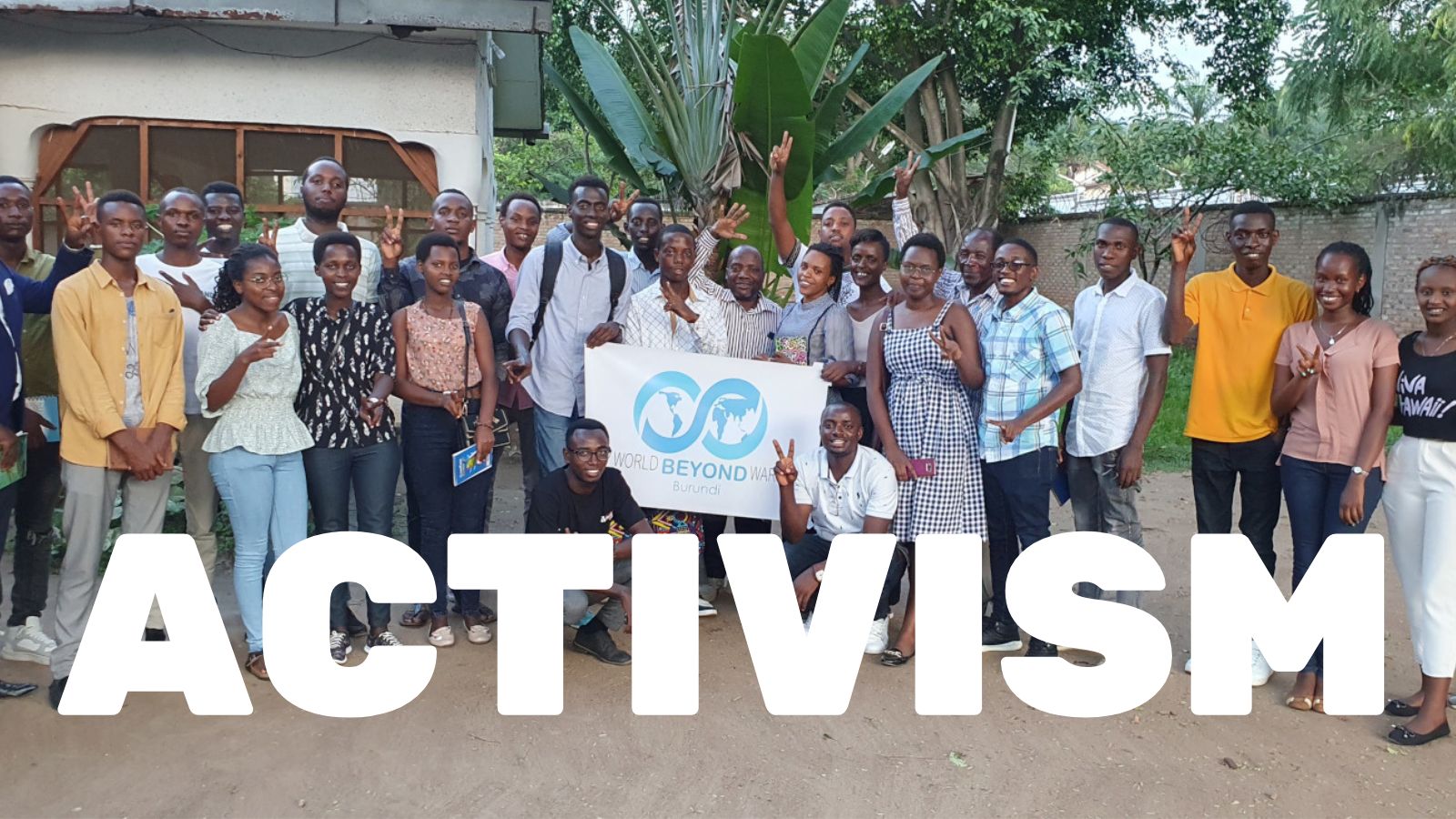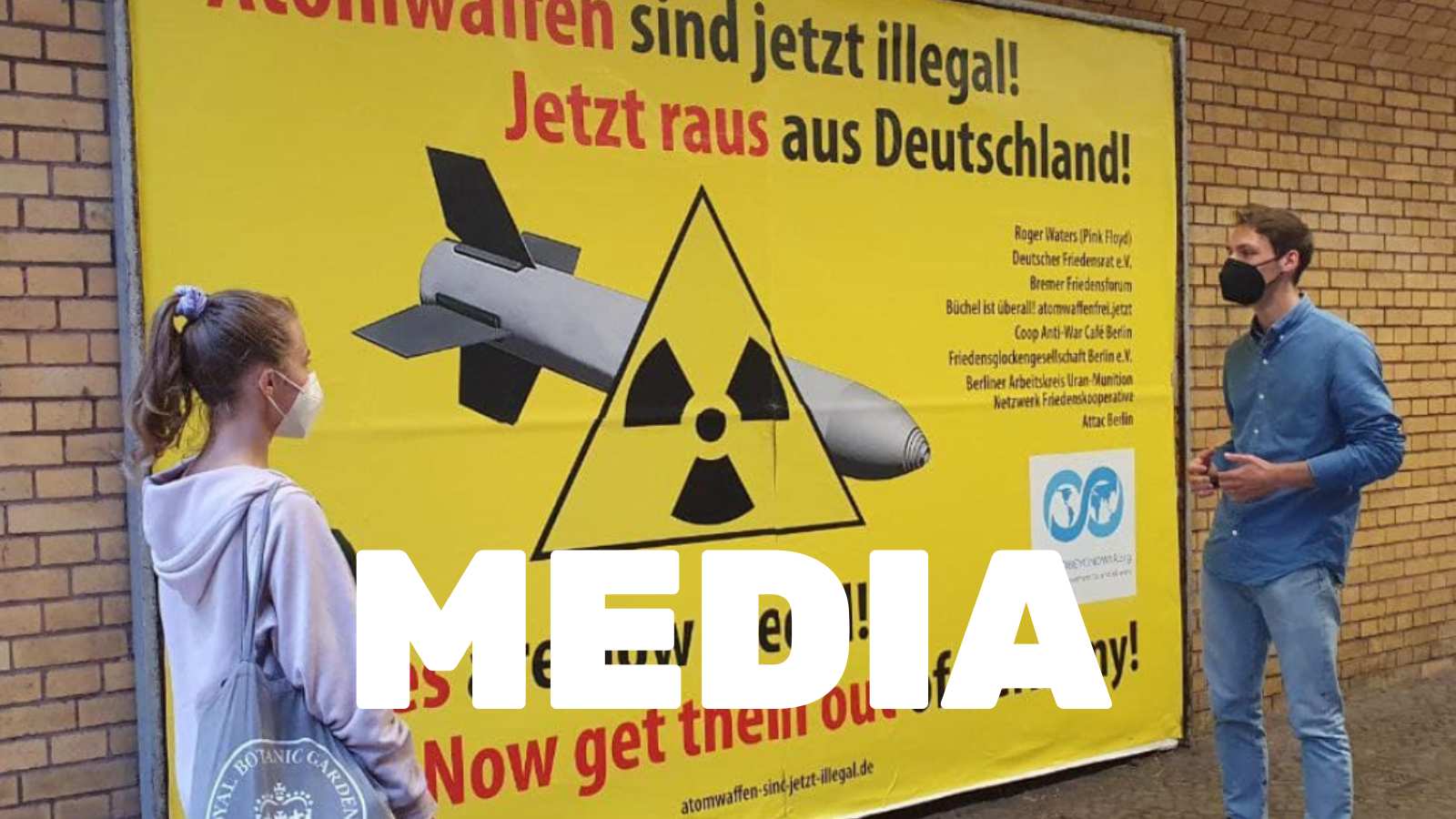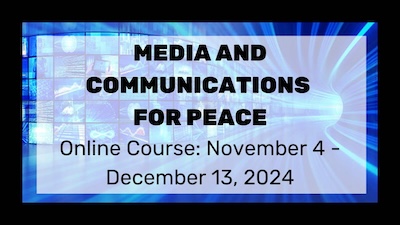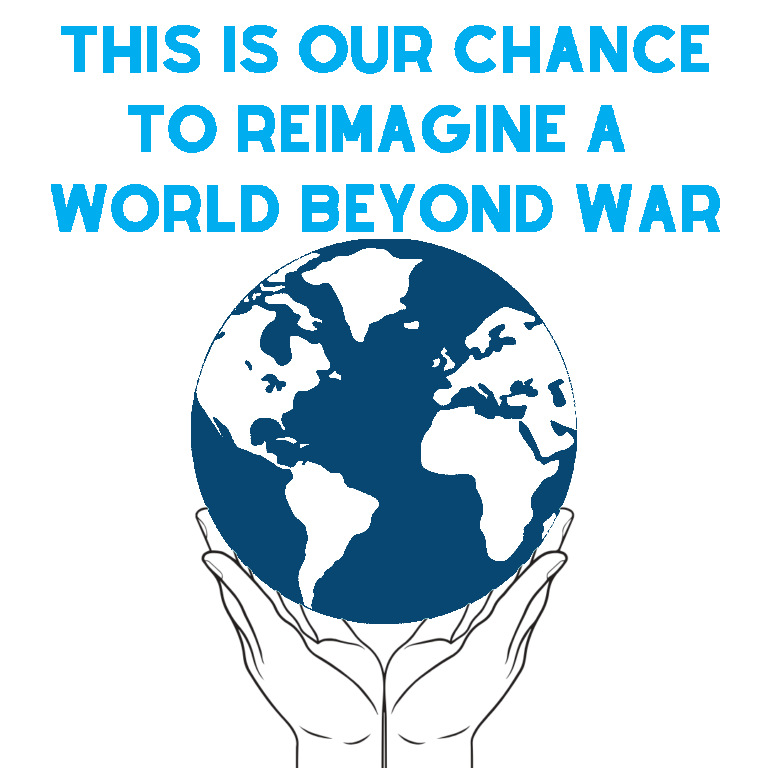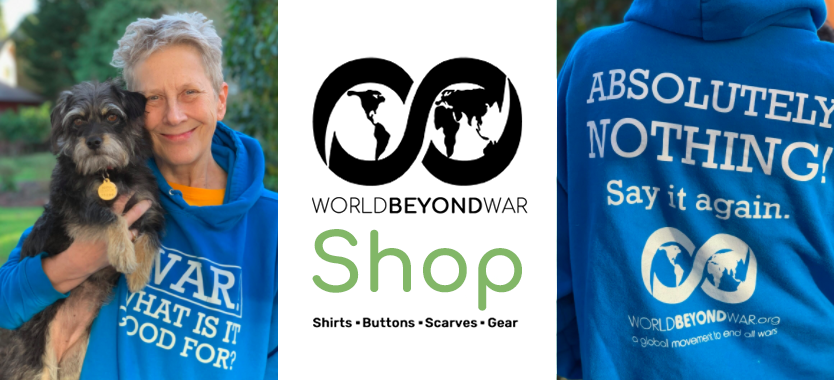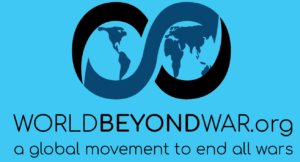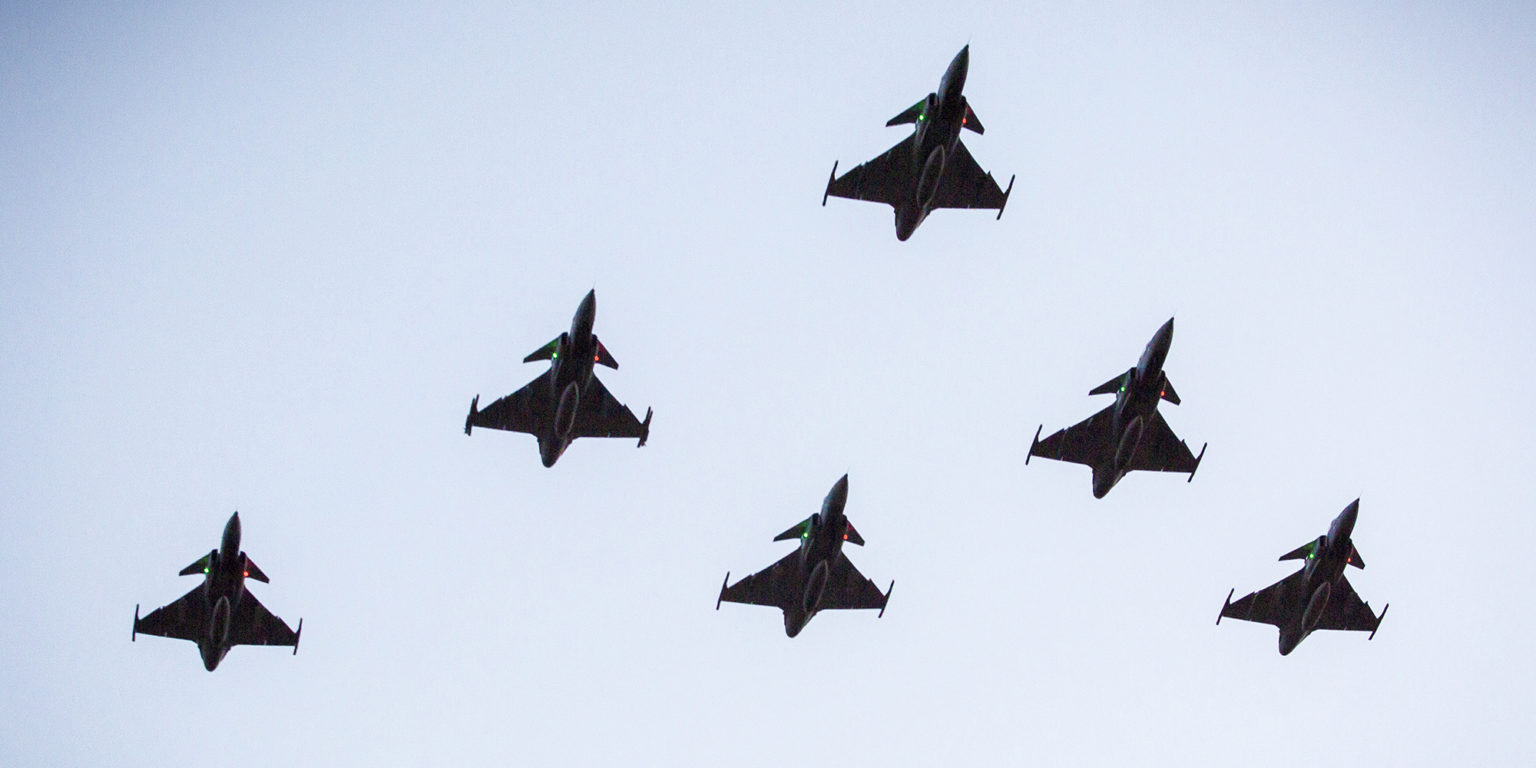
By Paul Holden, August 18, 2020
From Daily Maverick
South Africa is rapidly approaching a major milestone: in October 2020, the country will make its final payments on the loans taken out to pay for the purchase of submarines, corvettes, helicopters and fighter and trainer jets known collectively as the Arms Deal.
These purchases, formalised when the supply contracts were signed in December 1999, have profoundly defined and shaped South Africa’s post-apartheid political trajectory. The current crisis of State Capture and the epidemic of corruption that undermines Covid-19 relief and mitigation efforts, find their roots in the wholesale destruction of the capacity of the state to tackle corruption lest those capacities uncover the full rot of the Arms Deal.
This political cost is immense, but ultimately incalculable. But what is much more tangible and apt to be reduced to hard figures is the cost of the Arms Deal in real, hard, cash terms.
Using the best available information, I estimate that the cost of the Arms Deal, when adjusted for inflation, is equal to R142-billion in 2020 rand. Or, expressed another way, if the Arms Deal were to take place today, the total all-in costs to cover the purchases and the loans taken out to finance them, would be R142-billion. I have set out the calculations I’ve used to reach these estimates below in Part 2 for the more rigorous (read: nerdy) reader.
This distressingly impressive figure dwarfs some of the figures emerging out of the State Capture scandals. It is, for example, almost three times the value of the R50-billion in orders placed by Transnet with various Chinese state rail manufacturers, for which the Gupta criminal enterprise earned a juicy 20% kickback.
What could have been paid for instead?
What else could we have paid for if we spent that R142-billion now on things we actually needed (unlike a bunch of under-used fighter jets and tokenistic symbols of maritime power)?
For one, we could pay back the highly symbolic loan the government has just taken out from the International Monetary Fund (IMF). The $4.3-billion loan is equal to R70-billion. The money from the Arms Deal could pay this loan back twice over; or, more importantly, would have obviated the need for the loan in the first place.
The most recent budget provided R33.3-billion in funding for the National Student Financial Aid Scheme for the year 2020/2021. This scheme offers loans to undergraduate students to pay for their university tuition. South Africa could have funded this programme four times over if it used the Arms Deal money instead.
The same budget shows that the government planned to spend R65-billion on child-support grants. Using the Arms Deal money, we could have paid for this twice over, or, more generously, doubled the total value of child-care grants for a year.
But the figure that is most striking, especially amid the Covid-19 crisis and the national and global recession it will bring in its wake, is a recent estimate of how much it would cost per year to run a basic income grant scheme that would lift every South African between 18 and 59 above the real poverty line of R1,277 a month. Peter Attard Montalto of business forecasting firm Intellidex has suggested that it would cost R142-billion a year to do so: the exact cost of the Arms Deal in 2020 values.
Imagine that: for a whole year, amid a global pandemic that tears at the very fabric of South African society, every South African lifted out of poverty. The real long-term economic, psychological and political impact is scarcely conceivable.
Of course, a stickler may point out that these comparisons are a little unfair. The Arms Deal, in the end, was paid for over 20 years, not as a single lump sum. But what this ignores is that the Arms Deal was largely funded by foreign loans that covered the majority of the cost of the Arms Deal. The above expenditure, too, could have been funded with similar loans at a similar cost over 20 years. And that’s without lumping South Africa with military equipment it never really needed and which still costs a fortune to maintain and run.
Who made the money?
Based on my most recent calculations, South Africa paid R108.54-billion in 2020 rand to the British, Italian, Swedish and German arms companies that supplied us with fighter jets, submarines, corvettes and helicopters. This amount was paid over the course of 14 years from 2000 to 2014.
But what is often forgotten in discussions about the Arms Deal is that it wasn’t just the European arms companies that made a fortune out of the deal, but the major European banks that provided the South African government the loans to pay for the deal. These banks included Britain’s Barclays Bank (which financed the trainer and fighter jets, and which constituted the largest loans of all), Germany’s Commerzbank (which financed the corvette and submarines), France’s Societe Generale (which financed the corvette combat suite) and Italy’s Mediocredito Centrale (which financed the helicopters).
Indeed, my calculations show that South Africa paid just over R20-billion in 2020 rand in interest alone to European banks between 2003 and 2020. South Africa also paid a further R211.2-million (not adjusted for inflation) in management, commitment and legal fees to the same banks between 2000 and 2014.
Remarkably, some of these banks didn’t even take a risk when they gave these loans to South Africa. The Barclays loans, for example, were underwritten by a British government department called the Export Credit Guarantee Department. Under this system, the British government would step in and pay Barclays Bank if South Africa defaulted.
Rentier banking has never been so easy.
Some additional bad news
These comparisons, however, have to bear in mind another complicating factor: the R142-billion purchase price of the Arms Deal isn’t actually the total cost of the Arms Deal at all: this is just how much it has cost the South African government to buy the equipment and pay back the loans used to finance the purchase.
The government still has to spend considerable resources maintaining the equipment over time. This is known as the “life-cycle cost” of the equipment.
To date, there has been zero disclosure of how much has been spent on maintenance and other services on Arms Deal equipment. We do know that the costs have been so high that the Air Force confirmed in 2016 that only half the Gripen fighter jets are in active use, while half are kept in “rotational storage”, slashing the number of flying hours that are being logged by the SAAF.
But, based on international experience, we know that the long-term life-cycle costs are likely to be substantial. In the US, the most detailed recent estimate based on historical data suggests that operational and support costs for major weapons systems range from 88% to 112% of the acquisition cost. Applying this to the South African case, and using these same assumptions, South Africa will have to spend roughly double the capital cost of the Arms Deal over its intended life of 40 years if it is to maintain the equipment for operational use.
However, considering the lack of any hard data from the government on maintenance costs, I have decided not to include life-cycle costs in my calculations. But bear in mind that the figures I discuss below are nowhere near the full lifetime cost of the Arms Deal to the South African taxpayer.
Why prosecuting the Arms Deal still matters
Based on over two decades of investigations, leaks and prosecutions, we know that the European companies that sold South Africa equipment it did not need, paid out billions of rand in kickbacks and “consultancy fees” to politically connected players. And while Jacob Zuma is now finally set to face court time in relation to these kickbacks, this should only be the beginning: many more prosecutions must follow.
It is not just because this is what justice demands: it is because this could have major financial implications for the South African government. Vitally, all of the Arms Deal contracts included a clause stating that the arms companies would not engage in any corruption. Moreover, if the companies were found to have violated this clause in criminal prosecutions, the South African government could levy a fine of 10% in damages.
Importantly, these contracts were valued in US dollars, British pounds, Swedish Krone and Euros, which means that their rand value will have tracked with inflation and currency exchange fluctuations.
Using my estimates of the total cost of the deal, South Africa could recoup R10-billion in 2020 terms if all the Arms Deal suppliers were fined the full 10% amount allowed for in the contracts. This is nothing to sniff at, and only a fraction of what it would cost the government to bring these companies to justice.
Part 2: Estimating the total cost of the Arms Deal
Why don’t we know the full cost of the Arms Deal with 100% certainty?
It speaks volumes that we are still having to estimate the cost of the Arms Deal, rather than referring to a hard and concrete figure. This is because, ever since the Arms Deal was announced, its actual cost has been shrouded in secrecy.
The secrecy surrounding the deal was facilitated by the use of what is known as the Special Defence Account, which was used to account for Arms Deal expenditure in South Africa’s budgets. The Special Defence Account was set up during apartheid with the explicit intention of creating a budgetary black hole that could be used to disguise the extent of the country’s illegal international sanctions-busting.
Such secrecy meant that, for example, the total payments made out to Arms Deal suppliers was only first revealed in 2008, when it was declared in the national Budget for the first time. By then, tens of billions of rand had already been paid out.
However, these figures excluded the cost of the loans that were taken out to pay for the deal (in particular the interest paid and other administrative charges). This meant that, for many years, the only way to estimate the cost of the deal was to take the stated cost and add on 49%, which government investigations stated was the all-in cost of the financing.
In 2011, when I published a detailed account of the Arms Deal with my colleague Hennie van Vuuren, this is exactly what we did, developing an estimated cost of R71-billion at the time (not adjusted for inflation). And while this has turned out to be almost exactly right, we are now in a situation where we can look to develop something even more accurate.
The most detailed and full accounting of the cost of the Arms Deal was made public in the evidence of long-time and well-respected Treasury official, Andrew Donaldson. Donaldson supplied the evidence to the so-called Seriti Commission of Inquiry, which was tasked with investigating wrongdoing in the Arms Deal. As is now well known, the Seriti Commission’s findings were set aside in August 2019 as the Chairperson Judge Seriti and his fellow commissioner Judge Hendrick Musi were found to have failed to conduct a full, fair and meaningful investigation into the Arms Deal.
The way in which Donaldson’s evidence was dealt with at the commission was, in fact, a microcosm of how poorly the commission did its job. This was because, despite some very useful disclosures, Donaldson’s submission contained a vital ambiguity that the commission failed to identify or even question Donaldson about, leaving it unclarified – and the total cost of the Arms Deal still unclear.
The ambiguity in Arms Deal accounting
To understand the ambiguity in Donaldson’s statement one has to take an unpleasant detour into the workings of the Treasury and how different expenditures are accounted for in the national budget. Bear with me.
The Arms Deal was financed, in large part, by mega loans taken out from big international banks. These loans sat in pots, from which South Africa could take out money to pay the equipment suppliers. Practically, this meant that every year, South Africa would take some money out of the loan facilities granted to it by the banks (known as a “drawdown” on the loan), and use this money to pay the capital costs (that is, the actual purchase price) to the arms companies.
However, not all the money that was paid to the arms companies was drawn from these loans, as South Africa also used money in the existing defence budget to make the yearly payments. This amount was allocated from the national budget and formed part of typical government expenditure. This is shown graphically below:
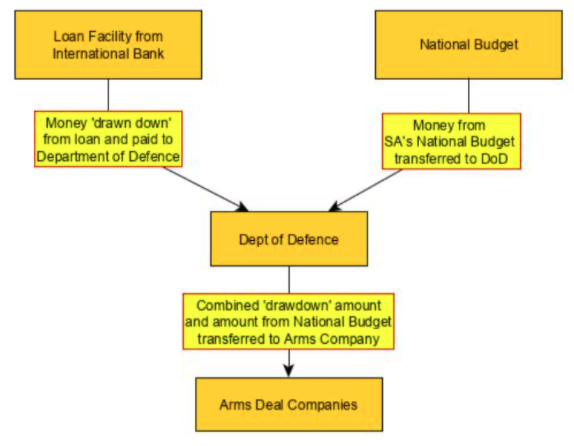
This means that we cannot simply rely on the total value of the loans and their interest to calculate the costs of the Arms Deal, as some of the cost of the deal was not covered by the mega loans, but instead paid for out of South Africa’s normal national operating budget.
Donaldson, in his evidence, stated that the real rand cost of the Arms Deal, or, in simpler terms, the amount paid directly to the arms companies, was R46.666-billion between 2000 and 2014, when the last payment was made. He also stated that, as of March 2014, South Africa still had to repay R12.1-billion on the loans themselves, in addition to a further R2.6-billion in interest.
Taking this at face value, and running with the figures, it would seem the easiest way to calculate the cost of the Arms Deal is to simply add the amount paid out to arms companies between 2000 and 2014 as reflected in the Department of Defence budget, and the amount still to be paid back on the loans including interest as of 2014, like this:

When added together in this way, we reach a figure of R61.501-billion. And, indeed, this was exactly the same figure reported in the South African media at the time, a mistake facilitated, in part, by the Seriti Commission’s failure to clarify Donaldon’s evidence.
The mistake lies in the fact that Donaldson’s evidence included a detailed table at the very end of his statement that explained how much had been paid to settle the capital and interest portions of the loans. This table confirmed that, up until 2014, an amount of R10.1-billion in interest had been paid over and above the repayments on the loan capital.
Logically, we can infer that this amount was not paid out of the Department of Defence budget, for two reasons. First, the amounts paid out of the Department of Defence budget were paid to the arms deal companies, not the banks. Second, as Donaldson also confirmed, loan and interest payments are accounted for in the National Revenue Fund, not specific departmental budgets.
What this means, simply, is that we have another cost to include in our cost of the Arms Deal formula, namely, the amount paid in interest between 2000 and 2014, which gives us the following:

Using this calculation we arrive at a total cost of R71.864-billion:

And now adjusting for inflation
Inflation is the increase in the cost of goods and services over time in a specific currency. Or, more simply, a loaf of bread in 1999 cost considerably less in rand terms than it does in 2020.
This is true of the Arms Deal as well. To get a sense of how much the Arms Deal really cost in terms we can understand today, we need to express the cost of the deal in 2020 values. This is because the R2.9-billion we paid out to arms companies in 2000/01 is not worth the same as R2.9-billion paid out now, just as the R2.50 we paid for a loaf of bread in 1999 is not going to buy a loaf of broad costing R10 in 2020.
To calculate the cost of the Arms Deal in 2020 values, I’ve performed three different sets of calculations.
First, I’ve taken the amounts paid to arms companies year by year out of the Department of Defence budget. I’ve then adjusted each yearly amount for inflation, to bring it up to 2020 prices, as so:
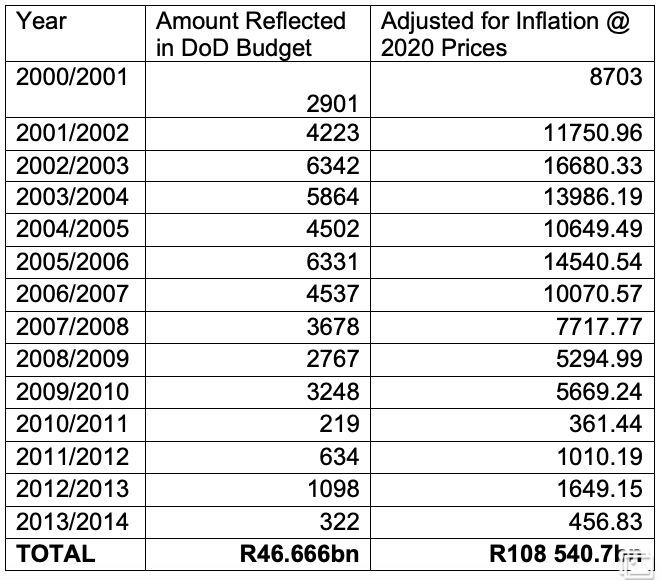
Second, for the interest already paid, I did the same thing. However, the government has never published how much was paid in interest every year. We do know, however, from Donaldson’s statement, what year the government started paying back certain loans, and we also know that loans were paid back in equal instalments every year. It is thus likely that the interest was paid back in the same way. I’ve thus taken the interest paid figure for each loan, and divided it by the number of years between when the loan was paid back and 2014 (the date of Donaldson’s statement), and then adjusted each year for inflation.
To use an example, the South African government took out three loans with Barclays Bank to cover the cost of the purchase of the Hawk and Gripen jets from BAE Systems and SAAB. Donaldson’s statement confirms that the loan was put into “repayment” mode in 2005, and that R6-billion had been paid back on the loans between then and 2014. Dividing this total amount equally between the years 2005 and 2014 and then adjusting for inflation gives us this calculation:
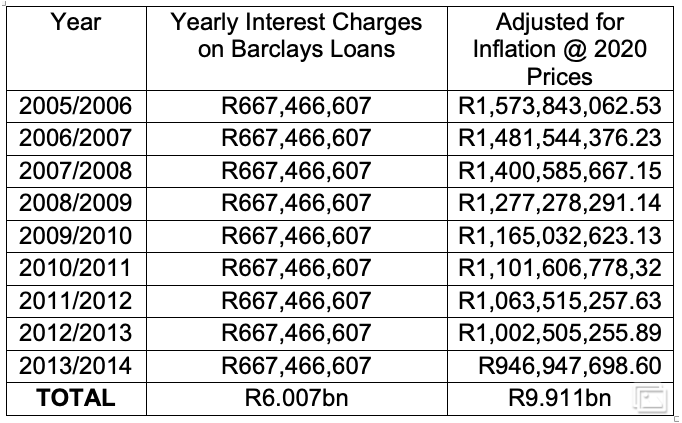
Finally, I’ve performed much the same calculation for the amounts still to be repaid on the loans (both capital and interest) from 2014. Donaldson’s statement confirmed that different loans would be paid off at different times. The loans for the submarines, for example, would be paid off by July 2016, the corvettes by April 2014, and the Barclays Bank loans for the Hawk and Gripen jets by October 2020. He also confirmed the total amounts to be repaid on each loan between 2014 and those dates.
To adjust for inflation, I’ve taken the amount that was reported as outstanding (both in capital and interest repayments on the loans), divided it equally by year up until the final payment date, and then adjusted each year for inflation. To use the Barclays Bank example again, we get these figures:
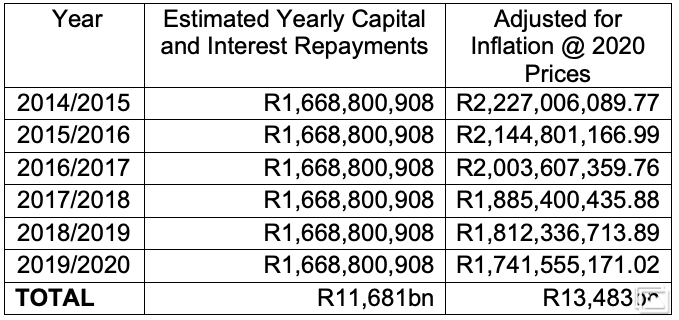
A careful reader would have noticed something important: the closer to the year 2020, the less the inflation is. It is possible, therefore, that my estimate is too high, because it is possible (although unlikely) that some of the interest payments were made closer to 2020 than to 2014.
Countervailing this is the fact that Donaldson’s statement gave the amounts to be paid back in rand figures. However, the loans were actually denominated in a mixture of British pounds, US dollars and Swedish krone. Considering the hammering the rand has taken against all of these currencies since 2014, it is highly likely that the rand amounts actually paid out were higher than what Donaldson’s statement said would be the case between 2014 and 2020.
With this caveat out of the way, we can now add all the amounts adjusted for inflation, coming to a total cost of R142.864-billion in 2020 prices:



